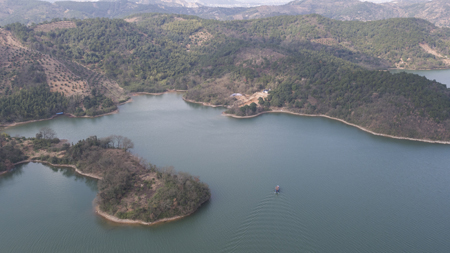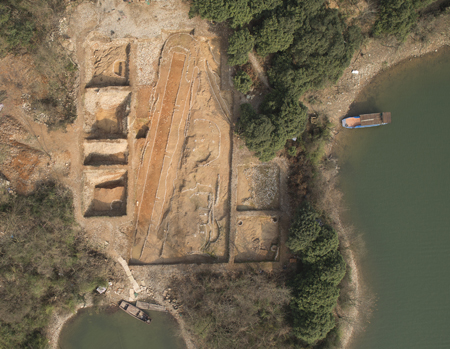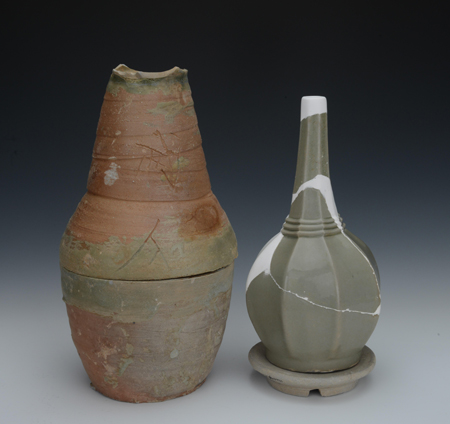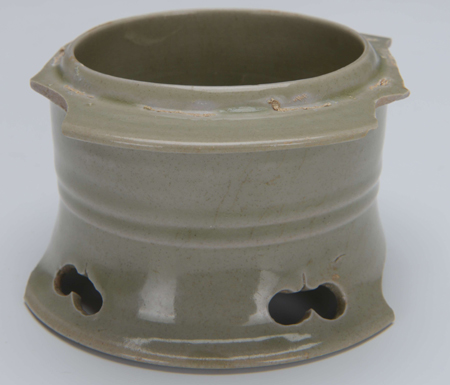The Housi’ao olive green porcelain Kiln Sites of Tang and the Five Dynasties Discovered in Zhejiang Province
From:Chinese Archaeology NetWriter:Date:2017-04-19
From Oct. 2015 to Jan. 2017, a joint archaeological team of Zhejiang Provincial Institute of Cultural Relics and Archaeology together and other institutes, conducted several excavations of the Kiln Sites at Housi’ao and under the water of the Shanglinhu Lake.
The distant view of the Kiln Sites at Housi’ao

The aerial photo showed Housi’ao kiln site
The excavations shed lights on the general features, production techniques, and the workshop plan of the mise glazed porcelain manufacture as well as the exploration of the relationship between mise glazed porcelain from the Tang Dynasty Famen Buddhist Temple’s underground storage and those from the Qian Family’s Tombs of the Wu and Yue states of the Five Dynasties.
The Housi’ao kiln site started in the Late Tang Dynasty and ceased in Five Dynasties. The kiln furniture with the inscriptions of “Dazhong” reign, “Xiantong” reign, and “Zhonghe” reign was found, demonstrating that the mise porcelain might have appeared during the “Dazhong” reign, developed during the “Xiantong” regin, become quite popular in the “Zhonghe” regin and witnessed a quality reduction after the middle Five Dynasties.
The vessel types were plenty, mainly including the cup, plate, bowel, small cup, and box, etc, as well as the pot, vase, jar, plate, censer, cavitas, and pillow, etc. The porcelain body was fine and smooth, and the glaze presented as the color of celeste without any impurity and rusty spot as the general celadon.

Olive green net bottle and its saggar
Based on the burning techniques, the appearance of the mise glazed porcelain was closely related with the use of porcelain sagger. The texture of the sagger was smooth and hard, almost the same with the porcelain. The sagger was sealed with glaze. The porcelain sagger appeared in the “Dazhong” reign, and kept increasing afterward. In the “Xiantong” reign the porcelain sagger took up a large occupation, and gradually took the place of the rough textured sagger during the “Zhonghe” reign. In the middle of Five Dynasties, the rough sagger was entirely replaced by the fine porcelain sagger with high quality. The porcelain saggers were commonly with carved characters, which were mainly family name, as well as names of the reigns, name of the vessels, auspicious words, and “official” mark (GUAN).
All the other features distributed with the kiln as the centre. The kiln was the traditional dragon kiln of the south area along with the hill, which was north-south faced and remained the smoke chamber in the tail part, doors and walls with complete structure. The kiln was built with bricks, while the outer wall was built by used saggers. The west side was thick deposit of the waste of the kiln, and there were many abandoned sagger walls between the waste and kiln. The east side was mainly the remains of the workshop, including two houses, glaze jars and mud tank, etc.

Olive green incense burner
The mise glazed porcelain unearthed in Housi’ao Site was similar to the one in underground storage of Famen Temple of the Tang Dynasty and Family Qian’s Tombs, Wu-yue State of Five Dynasties. Their burning techniques shared great similarities. Yet the eight-edge vase was only seen in Housi’ao Site. Therefore, most of the mise glazed porcelain in the Late Tang and Five Dynasties periods was from this kiln.
Lots of saggers have the inscription of “guan ( official)”, indicating that Housi’ao Site was the main kiln producing royal porcelain, presenting the highest level of porcelain making of the age. Making the mise celeste porcelain not only was a great progress in porcelain making, but also became the pronoun for high quality celadon, influencing the production and aesthetic orientation of the famous kilns in later ages, including the Ru kiln, Guan kiln of the South Song Dynasty, Longquan kiln, and even the Korea celadon. (Translator: Lang Langtian)

